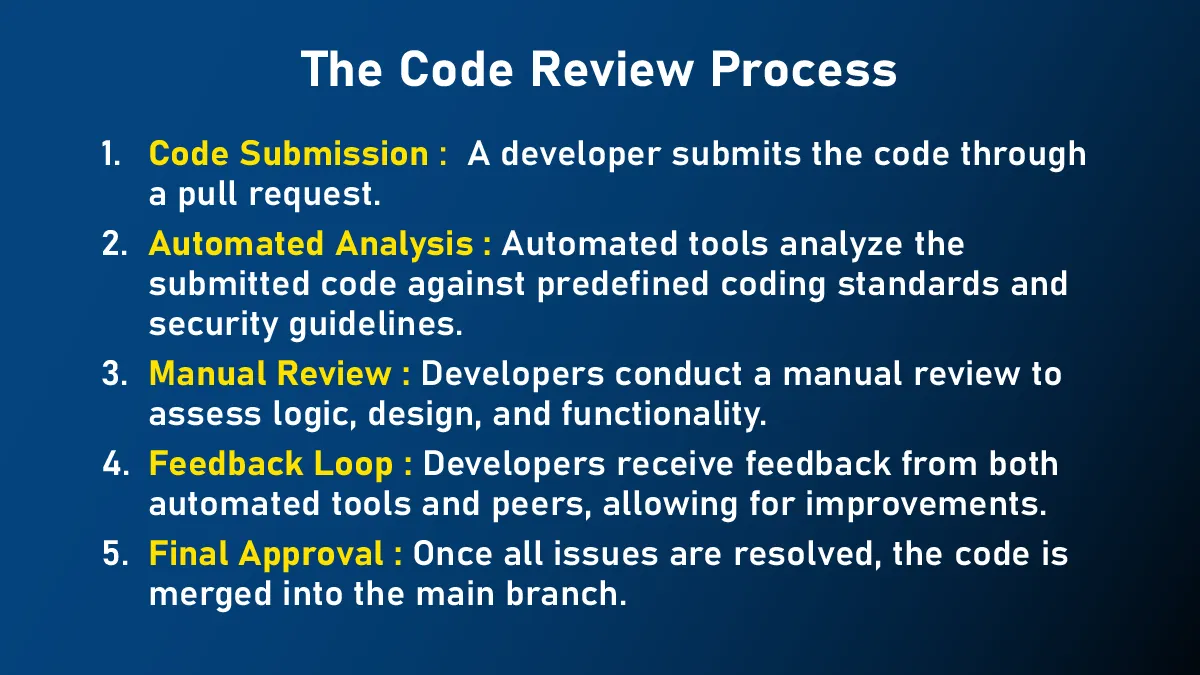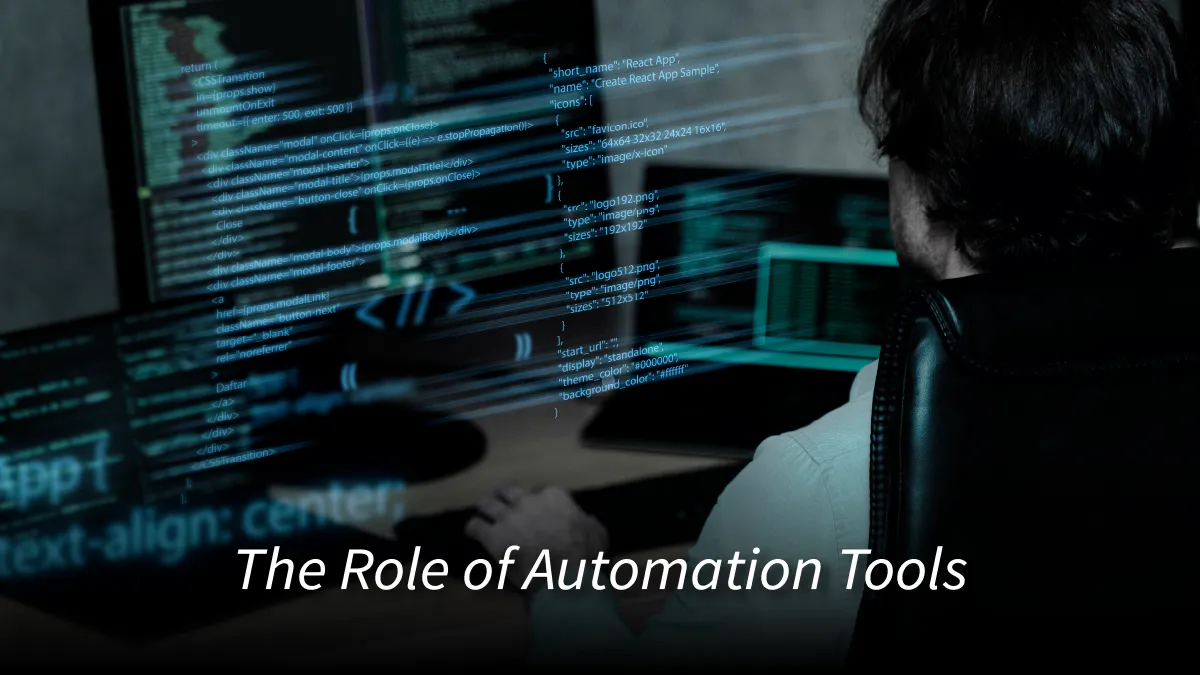What is Automated Code Review?
Automated code review is a process that utilizes tools to analyze source code for potential issues, security vulnerabilities, and adherence to coding standards. Unlike manual reviews, which rely on humans, automated tools can quickly scan large codebases. They find common errors and security threats. This process improves overall code quality by ensuring consistency across different programming languages and development teams.
The Code Review Process
 The code review process is critical in software development. It helps ensure high-quality code. Typically, this process involves both manual and automated reviews. Manual reviews are conducted by developers who examine the logic and design of the code. Automated tools perform static analysis to detect bugs and coding standard violations. Combining these approaches lets teams use human insight and machine efficiency. This will help them create robust and reliable software.
The code review process is critical in software development. It helps ensure high-quality code. Typically, this process involves both manual and automated reviews. Manual reviews are conducted by developers who examine the logic and design of the code. Automated tools perform static analysis to detect bugs and coding standard violations. Combining these approaches lets teams use human insight and machine efficiency. This will help them create robust and reliable software.
Steps in the Code Review Process:
- Code Submission – A developer submits the code through a pull request.
- Automated Analysis – Automated tools analyze the submitted code against predefined coding standards and security guidelines.
- Manual Review – Developers conduct a manual review to assess logic, design, and functionality.
- Feedback Loop – Developers receive feedback from both automated tools and peers, allowing for improvements.
- Final Approval – Once all issues are resolved, the code is merged into the main branch.
The Role of Automation Tools
Automation tools play a pivotal role in streamlining the code review process. They utilize static analysis techniques to check for compliance with coding standards and detect potential vulnerabilities. Automating these checks helps developers identify issues that may otherwise go unnoticed during manual reviews, significantly reducing the time spent on code evaluation. Some popular automated code review tools include SonarQube, Codacy, and ESLint. These tools can be integrated into existing development environments (IDEs) and version control systems like GitHub or GitLab, making them accessible to everyone.
Automation tools improve collaboration. They provide consistent feedback across the team. This ensures all developers follow the same coding standards. This consistency improves code quality and fosters a shared understanding of best practices among team members. Additionally, many of these tools allow for customization, allowing teams to tailor the analysis to their specific project needs and coding styles. As a result, automation tools save time and empower development teams to maintain high-quality code throughout the software development lifecycle.
Benefits of Automated Code Review
Automated code reviews offer numerous advantages that contribute to an efficient development process. In fact, 67% of developers who took the 2022 Global DevSecOps Survey said that their software development lifecycle is mostly or completely automated.
Time Savings: Automated tools can analyze vast amounts of code faster than manual reviews. This saves time and allows developers to focus on other tasks.
Improved Accuracy: Automated reviews reduce human error by applying coding standards to all submissions. This ensures that no critical issues are overlooked.
Enhanced Security: Automated tools identify vulnerabilities early in development. This lowers the risks of deploying insecure code.
Consistency: Automated tools apply the same rules uniformly across all projects, which helps maintain a coherent coding style and standard throughout the development team.
Scalability: Automated tools can easily scale to handle the increased workload associated with growing teams and projects without losing quality.
In addition to these benefits, automated code reviews foster a culture of continuous improvement within development teams, encouraging collaboration and knowledge sharing. Streamlining the review process lets teams respond to changes faster. They can then deliver better software more quickly. Ultimately, the integration of automated code reviews is a crucial step toward achieving a more efficient and effective development workflow.
Also Read: A Guide to Visual Testing: Definitions, How it Works in Software Development and Best Practices
Challenges of Automated Code Review
Automated code reviews provide significant benefits; however, they are not without challenges.
False Positives/Negatives: False Positives/Negatives: Automated tools may produce false positives or negatives. They may incorrectly flag compliant code or fail to find real issues. This can waste time or leave vulnerabilities undetected.
Limited Context Understanding: Automated tools often lack the understanding that human reviewers have. They may miss subtle logic errors or design flaws that need deeper insights.
Dependence on Tool Configuration: An automated tool’s effectiveness depends on its configuration. Poorly set rules can lead to ineffective reviews.
Illusion of Quality Control: Relying too much on automated code review tools can create a false sense of security about code quality. Teams may think automated checks are enough. This could lead to complacency and neglect of thorough manual reviews. This can result in critical issues being overlooked, ultimately affecting the quality of the software product.
These challenges highlight the need for a balanced approach that combines both automated and manual code review processes to ensure comprehensive quality assurance in software development.
Future of Automated Code Review
The future of automated code review holds immense potential for transforming software development practices. As technology advances, automated tools will become more sophisticated. They will use AI and machine learning to give better insights and feedback based on specific code.
These tools will not only identify potential issues but also learn from previous reviews, adapting their analyses to better suit the unique needs of each project. Moreover, the integration of automated code reviews within continuous integration and deployment pipelines will facilitate real-time feedback, accelerating development cycles and enhancing overall code quality. Human oversight is essential. But, collaboration between automated tools and developers will yield better workflows and higher-quality software.
Conclusion
Automated code review represents a transformative approach in software development that enhances both efficiency and quality. Integrating automated tools into the development process can save time while ensuring consistent adherence to coding standards and identifying security vulnerabilities early on. Despite its challenges, adopting automation alongside traditional manual reviews creates a robust framework for improving overall code quality. Adopting automated code review processes will be crucial for development teams as software projects continue to grow in complexity and scale. They can deliver high-quality applications efficiently while minimizing risks associated with security vulnerabilities and coding errors.































